

DEVELOPMENT GOAL, OBJECTIVES AND STRATEGIES
Introduction
The Municipal development focus for 2014-2017 was drawn in relation to the NMTDPF 2014-2017 which basic goal is to:
is
to achieve and sustain macroeconomic stability while placing the
economy on a path to higher and shared growth, reducing socio-economic
inequalities and ensuring rapid reduction in poverty in an enabling
environment .
District Development Focus
The DMTDP was formulated in line with the GSGDA II and the seven thematic areas of GSGDA II
· Ensuring and Sustaining Macroeconomic Stability
· Enhancing Competitiveness of Ghana’s Private Sector
· Accelerated Agricultural Modernization
· Oil and Gas Development
· Infrastructure, Energy and Human Settlements Developments
· Human Development, Employment and Productivity
· Transparent and Accountable Governance
The focus of the Municipality therefore does not deviate from that of the National Development Focus.
The Municipality
focuses on sustainable growth by expanding access to basic social
services, creating an enabling environment where law and order would
prevail to enhance economic activities, increasing productivity through
value addition by linking agriculture to industry (Agro-processing) and
employment opportunities most especially among the youth and finally
promote and facilitate the involvement of the citizenry especially the
vulnerable including women in decision making.
District Development Goal 2014-2017
The goal formulating process involved an analysis of the problems in relation to the potentials, opportunities, constraints and challenges identified in the Municipality as per the seven thematic areas of GSGDA II. In other words the Municipality goal was formulated around these thematic areas.
PRIORITIZATION OF DEVELOPMENT ISSUES
Introduction
The
community needs and aspirations were identified through consultations
with the Area and Urban councils. The key development issues were
harmonized under the GSGDA I (2010-2013) and further linked these
development issues to the adopted issues of the NMTDP (2014-2017).
Harmonization
Of Community Needs and Aspirations with Identified Key Development
Gaps/ Problems/ Issues From Review of Performance and Profiling from
2010-2013.
Community
needs and aspirations identified were harmonized by relating them with
the key gaps/ problems identified under the review of the performances
of District Medium Term Plan
2010-2013, the profile and other interventions. The scores range from 2
to 0. Below is a breakdown of the scores and their interpretations;
Score Definition
2 - Strong Relationship
1 - Weak Relationship
0 - No Relationship
The
scores were added together and divided by the total number of
community needs and aspirations to obtain the average score. A high
average score indicates a strong harmony of community needs and
aspirations and identified key development gaps/problems. A low score
indicates a weak harmony while zero score calls for review of the
community needs and aspirations.
Programmes Implemented
Among the gender sensitive pragmatic programmes the Assembly has adopted to promote gender balance include.
· Promotion of Girl Child Education
· Encouraging women to participate in local decision making
· Public campaign on elimination of Socio-Cultural Practices that have negative effect on female
· Provide care and support to PLHIV’S
Summary of Key Development Issues
From the situational analysis, and upon further consultation with relevant stakeholders, the following were identified issues that need to be addressed.
· Poor sanitation
· Haphazard and unconditional development
· High unemployment rate
· Deforestation
· Poor Roads
· Low access to credit facilities
· Low electricity coverage
· Poor performance in BECE
· Inadequate teachers accommodation
· Inadequate classroom blocks
· Low involvement of women in decision making
· Low access to quality health care
· Low Agricultural extension officers
· Undeveloped tourist potentials
· Low Internally Generated Fund
· Inadequate supply of potable water
· Low income
· Inadequate toilet facilities
· Low level of communal spirit
· Low level of agricultural production
· Destruction of farms by cattle
· Post-harvest losses
· Inadequate lorry parks
· Inadequate Police Personnel
· Inadequate Health Facilities
MONITORING AND EVALUATION ARRANGEMENT
Monitoring And Evaluation Plan (M &E)
The
M&E plan is a document that provides a guide for how M&E would
be conducted. The plan will assist the Assembly to measure progress
towards achievement of goals and objectives of the District Medium Term Development Plan 2014-2017.
Monitoring
It
is an on-going system of checking to make sure that the correct
procedures, practices, time frames, resources and targets are being
followed and achieved. Monitoring is an instrument that continuously
delivers structured information concerning the actual status of the
project to all persons involved in the implementation process, including
the target groups and beneficiaries.
Evaluation
It
is a process of determining systematically and objectively, the
relevance, effectiveness and impact of activities in the light of their
objectives.
Purpose of Monitoring and Evaluation
The implementation of the District
Medium Term Development Plan would cost the Assembly about
Gh¢17,536,200.00. There is therefore the need to ensure social gain.
Monitoring and evaluation would enable the beneficiaries to play a lead
role in keeping track of inputs, activities and/or progress towards
objectives on a more continuous (day to day) basis.
Again, monitoring and evaluation of the District Plan would further help to:
· Assess the Medium Term Development Framework.
· Identify achievement, constraints and failures so that improvements can be made to the Medium Term Development
Framework and project designs to achieve better impact.
· Provide information for effective co-ordination of Municipality development at the regional level.
· Provide the Municipality authorities, the government and development partners in the Municipality, community project management
teams and the general public with better means for learning from past experience.
· Improve service delivery and influence allocation of resources in the Municipality and demonstrate results of accountability
and transparency to people in the Municipality, NGOs, CSOs, FBOs and other stakeholders interested in the Assembly’s development.
· Reinforce ownership of the District Medium Term Development Plan (2010-2013) and also build M&E capacity within the
Municipality focusing on the Municipal Planning and Co-ordinating Unit.
Monitoring And Evaluation Arrangements
Section 46, Sub Section 3 of the Local Government Act, 1993, Act 462 established the District Planning Co-ordinating Unit (DPCU) to assist the Municipal
Assembly to execute designated planning functions. The National
Development Planning (Systems) Act, 1994, Act 480 empowers the DPCU to
be directly responsible for the development and implementation of the Municipal M&E plan.
In carrying out its M&E functions the Municipal
Planning and Co-ordinating Unit (MPCU), will co-opt representatives
from other sector agencies, private sector, CSOs, Development Partners,
Traditional Authorities, Communities and other stakeholders whose
inputs would be needed. The involvement of these stakeholders among
other things would contribute to hold the Municipal
Assembly more accountable and responsible for the delivery of goals
and services as well as exposing malfeasance and corruption. Again, it
would reinforce ownership of the Medium Term Development Plan
(2014-2017).
The Development Partners will shape and enhance M&E at the Municipal level. The Development Partners for example would strengthen the institutional framework for evidence based planning, M&E. Furthermore, their involvement in the M&E process of the Assembly would build their confidence to provide support to the development agenda of the Assembly.
DEVELOPMENT OF COMMUNICATION STRATEGY
Introduction
The implementation of MTDPF would be incomplete if the major stakeholders who assisted in drawing the plan are left out and would not know the progress made during the implementation. It is therefore crucial and necessary to develop out communication strategy.
Communication
on the District medium Term Development Plan (DMTDP) is important for
sensitizing the citizenry and targeted interest groups/stakeholders
about the DMTDP,building confidence in the development partners, improve
service delivery and to reinforce sense of ownership.
A lot of
resources both financial and material would go into the implementation
of the District Medium Term Development Plan. It is therefore
imperative for the people/beneficiaries to know on any issues
concerning its implementation.
The
implementation of the strategy will ensure social accountability and
reduce/minimise apathy, improve the level of communal spirit and the
level of participation in social functions.
Date Created : 5/22/2019 9:33:15 AM












 facebook
facebook
 twitter
twitter
 Youtube
Youtube
 +233 593 831 280
+233 593 831 280 0800 430 430
0800 430 430 GPS: GE-231-4383
GPS: GE-231-4383 info@ghanadistricts.com
info@ghanadistricts.com Box GP1044, Accra, Ghana
Box GP1044, Accra, Ghana